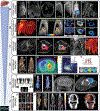Preclinical Applications of Multi-Platform Imaging in Animal Models of Cancer
- PMID: 33262127
- PMCID: PMC8026542
- DOI: 10.1158/0008-5472.CAN-20-0373
Preclinical Applications of Multi-Platform Imaging in Animal Models of Cancer
Abstract
In animal models of cancer, oncologic imaging has evolved from a simple assessment of tumor location and size to sophisticated multimodality exploration of molecular, physiologic, genetic, immunologic, and biochemical events at microscopic to macroscopic levels, performed noninvasively and sometimes in real time. Here, we briefly review animal imaging technology and molecular imaging probes together with selected applications from recent literature. Fast and sensitive optical imaging is primarily used to track luciferase-expressing tumor cells, image molecular targets with fluorescence probes, and to report on metabolic and physiologic phenotypes using smart switchable luminescent probes. MicroPET/single-photon emission CT have proven to be two of the most translational modalities for molecular and metabolic imaging of cancers: immuno-PET is a promising and rapidly evolving area of imaging research. Sophisticated MRI techniques provide high-resolution images of small metastases, tumor inflammation, perfusion, oxygenation, and acidity. Disseminated tumors to the bone and lung are easily detected by microCT, while ultrasound provides real-time visualization of tumor vasculature and perfusion. Recently available photoacoustic imaging provides real-time evaluation of vascular patency, oxygenation, and nanoparticle distributions. New hybrid instruments, such as PET-MRI, promise more convenient combination of the capabilities of each modality, enabling enhanced research efficacy and throughput.
©2020 American Association for Cancer Research.
Conflict of interest statement
The authors declare no potential conflicts of interest
Figures

References
-
- de Jong M, Essers J, van Weerden WM. Imaging preclinical tumour models: improving translational power. Nature reviews Cancer. 2014;14(7):481–93. - PubMed
-
- Weissleder R, Schwaiger MC, Gambhir SS, Hricak H. Imaging approaches to optimize molecular therapies. Science translational medicine. 2016;8(355):355ps16. - PubMed
-
- Hausner SH, Bold RJ, Cheuy LY, Chew HK, Daly ME, Davis RA, et al. Preclinical Development and First-in-Human Imaging of the Integrin alphavbeta6 with [(18)F]alphavbeta6-Binding Peptide in Metastatic Carcinoma. Clinical cancer research : an official journal of the American Association for Cancer Research. 2019;25(4):1206–15. - PMC - PubMed
Publication types
MeSH terms
Substances
Grants and funding
- P30 DK048520/DK/NIDDK NIH HHS/United States
- R01 CA213492/CA/NCI NIH HHS/United States
- S10 OD018094/OD/NIH HHS/United States
- R01 AI154959/AI/NIAID NIH HHS/United States
- P30 CA046934/CA/NCI NIH HHS/United States
- P30 CA142543/CA/NCI NIH HHS/United States
- R01 CA194058/CA/NCI NIH HHS/United States
- S10 OD023485/OD/NIH HHS/United States
- S10 OD027023/OD/NIH HHS/United States
- R01 CA264901/CA/NCI NIH HHS/United States
- R01 CA213428/CA/NCI NIH HHS/United States
- UL1 TR002535/TR/NCATS NIH HHS/United States
- S10 OD023491/OD/NIH HHS/United States
LinkOut - more resources
Full Text Sources

